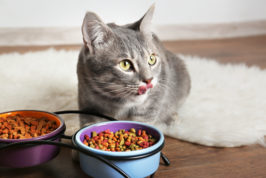Health Issues for Elderly Cats
- What is considered ‘old age’ for a cat?
- Do I need to care for my cat differently as they age?
- What is the most common disease in elderly cats?
- Osteoarthritis
- Chronic kidney disease
- Hyperthyroidism
- Dental disease
- High Blood Pressure
- Cancer in cats
- Dementia
- How do I know if my cat is suffering?
- Frequently Asked Questions about Elderly Cats
- Conclusion
A common question I get asked as a vet is, “What is the most common disease in elderly cats?”. This is hard to answer, but there are several ailments that are worth keeping an eye out for as your cat ages. This article covers how to look after your cat in their senior years, and what symptoms you should be on the lookout for to ensure your cat lives a long and healthy life.
What is considered ‘old age’ for a cat?

Cats are long-lived compared to dogs, rabbits, and other domesticated pets. The average life expectancy of a cat is around 14–16 years, but many cats make it to their 20s! The oldest cat currently alive is hotly debated, but Crème Puff – who died in 2005 at 38 years old – holds the record for longest-lived cat.
So, when is a cat considered a ‘senior’? According to International Cat Care, a cat is considered ‘senior’ when they reach 11 years of age, and they progress to ‘geriatric’ at 14 years of age. As with dogs, life expectancy (and therefore the age a cat reaches ‘old age’) can vary from breed to breed, with large and giant breeds tending to have shorter lives than mid-sized or smaller cats.
Even within a breed, individuals can have hugely different lifespans. Some cats start going grey and displaying old-age behaviours as young as eight, whilst others will appear sprightly and youthful well into their teens.
Do I need to care for my cat differently as they age?
If you’re wondering how to care for your cat as they get older, you might be surprised to hear there are a few things you should do differently. Firstly, annual exams with your vet become even more important – this can help pick up diseases earlier so that you can treat your cat sooner.
Secondly, you may need to consider changing their diet. Whilst there are no specific guidelines for what a ‘senior’ diet should include, most manufacturers reduce phosphorus and alter protein source to be gentler on the kidneys. Other changes you may want to make include moving their food and water bowl, reconsidering their toileting options, and making sure their sleeping area is warm and comfortable.
You’ll also need to keep a close eye on your cat’s health and behaviour. Cats are masters at hiding signs of disease, meaning your instincts and the little changes you notice at home become all the more important. For diseases like arthritis, high blood pressure and dementia, behavioural changes are the first sign that something isn’t right. For other diseases – like kidney disease, dental disease and hyperthyroidism – you’ll likely spot changes in your cat’s eating and drinking habits, so becoming familiar with these is important.
What is the most common disease in elderly cats?
As cats age, their bodies become more prone to conditions and diseases including kidney disease, hyperthyroidism, high blood pressure, dental disease, dementia, arthritis, and cancer.
Whilst there’s some debate, arthritis should probably be considered the most common disease of elderly cats, with some studies claiming it affects 90% of cats over 12.
Chronic kidney disease is also very common, affecting at least one in three cats over the age of 15, with male cats generally being affected at a younger age than females. With many common diseases in elderly cats, we don’t have accurate numbers to work out how many cats are affected. Let’s look in more detail at some of the more common diseases that your senior cat may experience.
Osteoarthritis

Arthritis (its proper name being osteoarthritis) is very common in cats. Like arthritis in humans, feline arthritis is a painful joint disease that steadily gets worse over time. However, because cats are so good at hiding the signs of pain, this disease often goes unnoticed, and is underdiagnosed.
What are the symptoms of arthritis in cats?
Whilst arthritis in cats is subtle, there are a few behavioural changes you might notice at home.
- Coat changes, due to lack of grooming
- Missing jumps, or reluctance to jump
- Sleeping more
- Stiffness, limping, or change in gait
- Litter tray problems
How is arthritis in cats diagnosed and treated?
Your vet will want to take a thorough history. Whilst they’ll examine your cat thoroughly, they may not be able to detect arthritis – cats are very good at being brave at the vets! Sometimes, an x-ray may be recommended, but commonly a pain relief trial is undertaken. This involves giving pain relief for a week or two and assessing the response. Then the pain relief is stopped, and we see whether the symptoms return. This is a good way of testing whether those subtle changes are due to pain or not.
Once you know that your cat has arthritis, they’ll need to go onto long-term medication. Joint supplements, weight loss, and changes to the house environment can also help cats with arthritis.
Chronic kidney disease

Chronic kidney disease (also known as CKD, renal failure, or chronic kidney injury) becomes steadily more common as cats age, meaning it’s very common in older cats.
What are the symptoms of kidney disease in cats?
Kidney disease worsens over time. The early signs can be subtle and easy to miss, but it usually gets diagnosed rapidly as the signs get worse. The signs of kidney disease in cats to look out for include:
- Increased thirst, and drinking from strange places
- Increased urination, accidents outside the tray, or frequent trips outdoors
- Weight loss
- Poor coat
- Lethargy
- Diminished appetite, nausea, and vomiting
How is kidney disease in cats diagnosed and treated?
Cats with signs of kidney failure need to see the vet for a diagnosis. If they agree that renal disease is a possibility, they’ll recommend blood samples looking at urea and creatinine – two by-products your cat’s kidneys should remove from their body. If these are raised, it suggests your cat’s kidneys aren’t doing a good enough job, and your vet will usually make a diagnosis of renal failure. Other tests including urine samples, blood pressure tests, and ultrasound may help your vet to define exactly what’s happening.
Whilst there’s no treatment for renal failure in cats, there are things you can do to manage the disease.
A prescription kidney cat food will be recommended, and kidney supplements may also be an option. For cats with high blood pressure, blood pressure tablets will be required to bring this under control. Other symptoms, such as nausea, are treated with medications if your cat is showing signs, and some cats may need to stay in for a fluid drip into the veins to rehydrate them from time to time.
Hyperthyroidism
Hyperthyroidism in cats is another really common disease of older felines, affecting around one in 10 cats over 10 years old in the UK.
In most cases of hyperthyroidism, a benign tumour of the thyroid gland causes cats to overproduce thyroid hormone, giving them a faster-than-normal metabolism.
What are the symptoms of hyperthyroidism in cats?
Early hyperthyroidism often gets missed, as the early signs can be misinterpreted as a ‘new lease of life’ – but as the disease progresses, cats can go downhill suddenly. Keep an eye out for the symptoms of hyperthyroidism, like:
- Increased appetite
- Increased thirst and urination
- Weight loss
- Increased energy/hyperactivity
- Yowling/meowing
- Aggression and other behavioural changes
- Vomiting and diarrhoea
How is hyperthyroidism in cats diagnosed and treated?
If you suspect your cat has hyperthyroidism, you should book an appointment with your veterinarian who will examine your cat thoroughly. Many cats with hyperthyroidism have a fast heart rate, and the thyroid tumour may even be felt in the neck. Your vet will also need a blood sample from your cat, to measure the amount of thyroid hormone they are producing.
Hyperthyroidism can either be treated (and possibly cured), or the symptoms and progression managed, depending on your cat and available finances. Radioactive iodine therapy is the gold-standard treatment for feline hyperthyroidism, but it’s expensive and involves an extended stay at a referral centre – which may not be a good option for some cats. Surgery can also cure hyperthyroidism but comes with risks. Daily medication is suitable for many cats and is cheapest in the short-term – there are tablets, liquids, and even topical creams available.
Dental disease

Dental disease, or periodontitis, is extremely common in cats. In fact, one recent study had it affecting more than one in 10 cats of all ages, making it the most frequently diagnosed condition in feline general practice. Cats suffer from many dental diseases, but periodontitis – inflammation of the gums and ligaments holding the tooth in position – is the most common.
What are the symptoms of dental disease in cats?
Cats with dental disease hide their symptoms well. You might notice:
- Bad breath
- Change in food preference
- Chewing strangely, or dropping food
- Drooling
- Red gums
- Pawing at mouth
How is dental disease in cats diagnosed and treated?
If dental disease is severe, the signs might be noticed in an examination. Otherwise, dental x-rays and an examination under anaesthesia help us to diagnose the type and extent of the problem.
Periodontitis needs to be treated with a scale and polish (to remove tartar and reduce bacteria in the mouth) and then the damaged teeth are removed. Whilst this may seem drastic, damaged and wobbly teeth are painful and will fall out eventually – removing them is a better option and allows us to control the pain. Don’t worry, though – cats do fine without all their teeth!
Unlike many of the other diseases of old cats we discuss in this article, it’s possible to prevent periodontal disease, or reduce your cat’s risk. Frequent toothbrushing is the best option, and cats can be trained to allow this, but you may find that dental diets and water additives are the only option for your cat.
High Blood Pressure
High blood pressure (properly called ‘hypertension’) is fairly common in older cats, although it’s not clear how many cats suffer with it. High blood pressure usually affects cats older than nine and becomes more common as cats age – being very likely by the time a cat reaches 15 years old. It can be caused secondary to renal disease, hyperthyroidism, and heart disease, but some cats don’t have an easy-to-find underlying cause.
What are the symptoms of high blood pressure in cats?
If cats have high blood pressure alongside another disease, you may notice the symptoms of kidney failure or hyperthyroidism first. However, severe undiagnosed high blood pressure in cats also causes symptoms, including:
- Behavioural changes, such as yowling and confusion
- Pressing head against the wall
- Abnormal, continuous circling
- Sudden blindness
How is high blood pressure in cats diagnosed and treated?
Your cat’s blood pressure can be measured using a similar device to that used in humans. It should ideally be measured conscious, in a calm cat, and several readings are taken to get an average result. Your vet may also need to conduct other tests to look for the common causes of high blood pressure.
Once high blood pressure has been diagnosed, daily medication can help to control it. Your cat will need regular readings to check that the dose of medication is right for them.
Cancer in cats

Like humans and dogs, cats can get lots of types of cancer, many of which become more common as cats age. Skin cancers, intestinal cancers, and lung cancers are relatively common in cats, as are blood cancers, especially lymphoma. Breast cancer is fairly common in unneutered female cats.
What are the symptoms of cancer in cats?
The symptoms of cancer depend where the tumour is growing, what it’s pressing on, and what it’s made up of.
Some tumours can be small but produce hormones or chemicals that cause problems throughout the body. Others are larger but aren’t obvious until they press on something important. General signs of cancer in cats include:
- Changes in appetite
- Weight loss
- Muscle loss
- Lethargy
- Vomiting or diarrhoea
- Visible lumps, bumps, masses and rashes
How is cancer in cats diagnosed and treated?
To diagnose cancer, a biopsy of the tumour is usually needed. This can be easy if a lump is visible, but much harder if it isn’t. Therefore, blood tests, ultrasounds, x-rays, and other types of imaging may be used to try to find the lump, so that it can be sampled if possible.
Depending on the type of cancer, surgery, chemotherapy, radiation, or palliative care may be recommended. Some skin tumours may be able to be removed entirely with surgery, whilst more ‘diffuse’ tumours like blood cancers or intestinal lymphoma usually require chemotherapy. Your vet will go through the prognosis and treatment options if your cat has been diagnosed with cancer.
Dementia

Feline dementia (or ‘feline cognitive dysfunction’) is another common illness in elderly cats, but it’s poorly understood compared to some of the other conditions on this list. Like human and canine dementia, cats show neurodegenerative changes that cause abnormal behaviours in old age.
How do I know if my cat has dementia?
Common signs of dementia in cats include:
- Changes in sleep-wake pattern
- Disorientation or confusion
- Anxiety
- Clinginess, or unusual aggression
- Litter box problems
- Vocalising – meowing loudly
How is dementia diagnosed and treated in cats?
There is no specific test for feline dementia. However, vets will want to check bloodwork to rule out other causes of strange behaviour, such as hyperthyroidism. It’s likely they’ll also check blood pressure, as some of these symptoms are similar to high blood pressure.
Similarly, feline dementia has no specific treatment. However, as with canine dementia, brain-boosting supplements are thought to help. Other symptoms can be managed using environment changes, such as nightlights and a predictable routine to help to manage anxiety.
How do I know if my cat is suffering?
Any of the old-age diseases listed above can cause suffering, which is why it’s important to get your pet checked out as soon as you suspect a problem.
With good management, many cats can live for months or years with these conditions, but your vet will discuss your cat’s prognosis when a diagnosis is made.
However, even with good management many of these diseases will progress. Unfortunately, there usually comes a time when you have to decide whether your cat still has a good quality of life. This can be hard to assess in an elderly cat, especially if they like to sleep a lot. Try to think about whether they can do the things that make them happy, or not. Your vet can talk you through deciding whether your cat is suffering, and how to make the decision to say goodbye.
Frequently Asked Questions about Elderly Cats
Several diseases can cause elderly cats to meow more than usual. Hyperthyroidism can cause hyper behaviour, emotional changes (usually, more skittish and grumpier) and excessive vocalisation. Similarly, high blood pressure in older cats can cause them to become noisier and meow loudly. Dementia can also cause an elderly cat to become noisier – possibly because they’re anxious. For instance, a cat with dementia may meow loudly if they can’t find you. Cats may also meow more when they’re nauseous, which could be a sign of several of the common conditions in elderly cats listed above.
Because abnormal vocalisation can mean so many things, it’s best to talk to your veterinarian about your cat’s changes in behaviour. Hopefully, a quick check-over and a blood test will rule out many of these common conditions, and you’ll be able to trial some dementia treatment for your cat – but it’s better safe than sorry!
As cats age, they become prone to many diseases that cause weight loss, including hyperthyroidism, kidney disease, and cancer. They can also have appetite changes meaning they struggle to eat the required number of calories. Elderly cats are also less active, and often lose muscle mass rather than fat. You might be able to see this as hollow areas on your cat’s back thighs, or a prominent spine.
If your elderly cat is losing weight, or simply isn’t gaining it, it’s best to book an appointment with your vet. It’s likely they will recommend blood tests as a starting point to try to work out what is going on.
Conclusion
As cats age, the chance of them developing a health condition increases. It’s hard to decide what is the most common health condition in older cats, but they’re prone to many. If you think your cat is suffering from any of these common health issues in older cats, or you’ve noticed symptoms that aren’t discussed here, it’s best to approach your vet. In addition, annual visits to the vet as your cat ages are essential – in fact, for ‘geriatric’ cats, I recommend having them seen every six months, so that health issues can be diagnosed and treated sooner.




